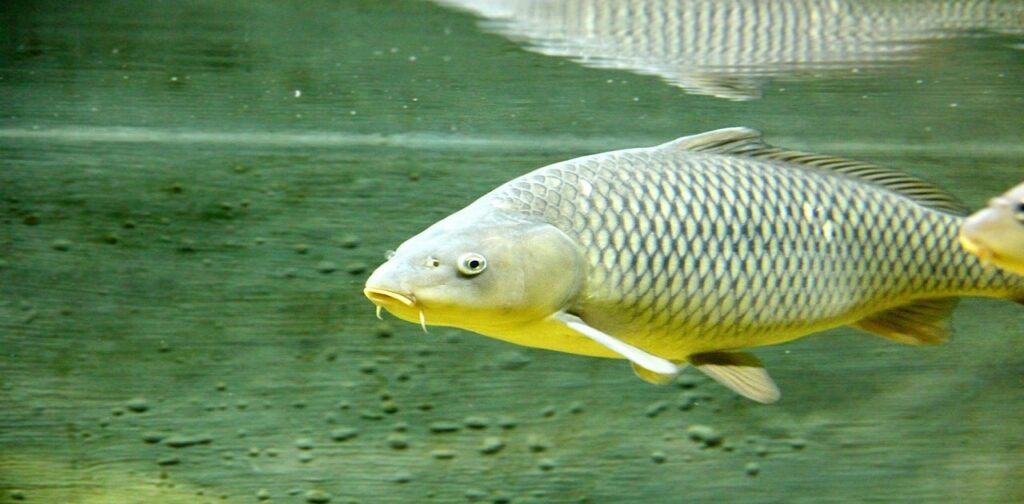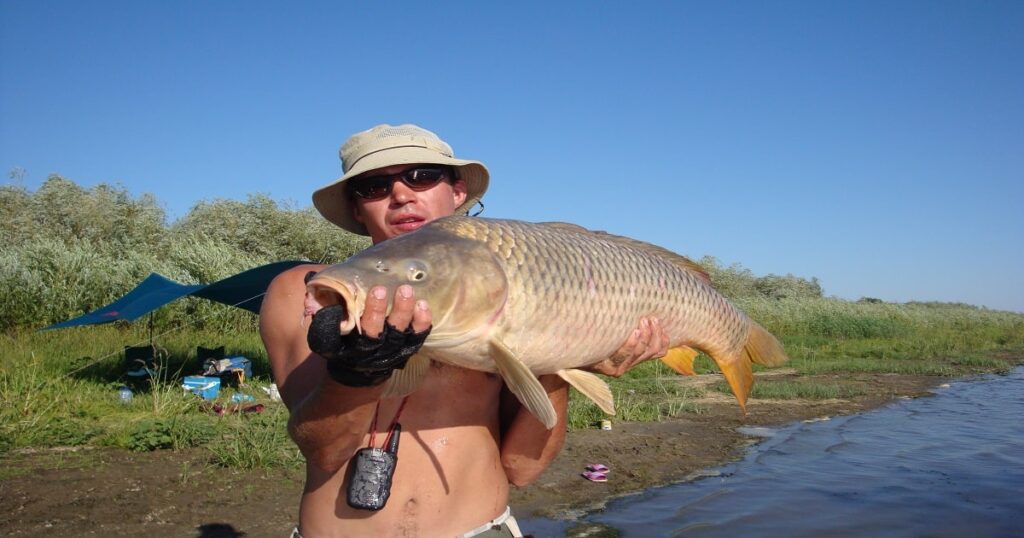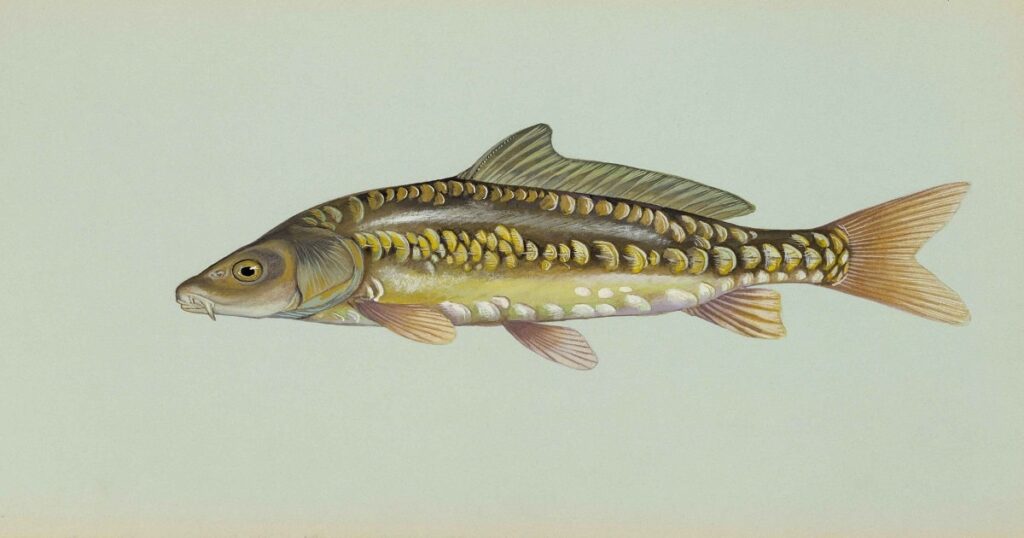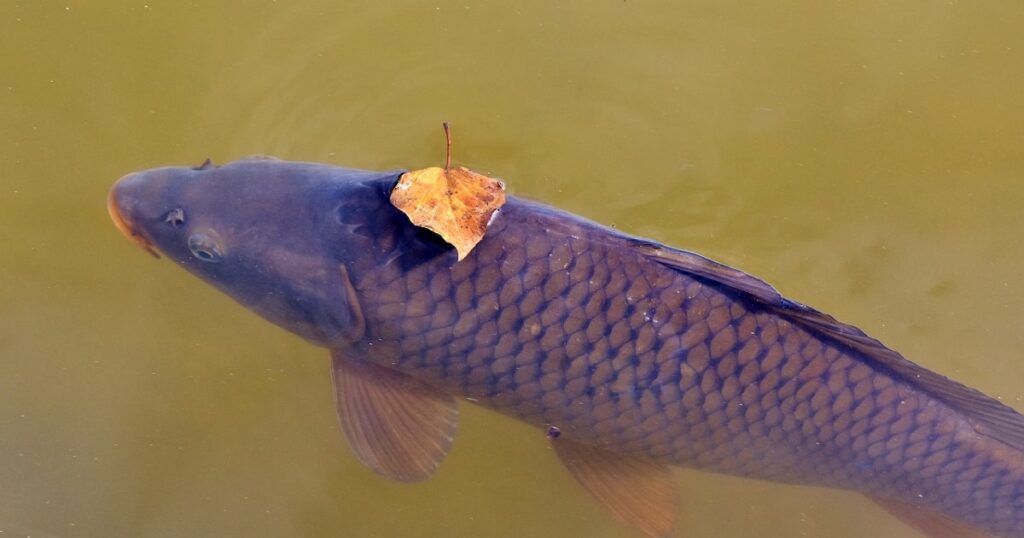Carp, including the common carp and mirror carp, are freshwater fish species that are widely distributed throughout Europe and Asia. They are a favourite among anglers due to their impressive sizes and challenging fight. This article will delve into the habitat, feeding habits, size and lifespan, record catches, identification, and techniques to catch them.
Carp Habitat
Carp are versatile and can adapt to various freshwater habitats. While they thrive in still waters like lakes, ponds, and reservoirs, they are also found in rivers and canals. Carp are often spotted basking near the surface during warmer days, especially in the shallows, while during the winter months they can often be found in the deepest sections of the lake and river in search of warmer water.

Feeding Habits
Carp are omnivorous, consuming a mix of aquatic plants, insects, crustaceans, and smaller fish. They are especially keen on bloodworms, snails, and various aquatic insects. Carp have a tendency to sift through the bottom substrate to find food, often disturbing the sediment in the process.
In terms fishing for carp popular baits include:
- Boilies – These are specialized carp baits, often made of a mix of proteins, binders, and flavourings. These are the go-to choice for many carp anglers and have produced many lake records over the years. You can get boilies in your local tackle shop or make your own secret boilies with this guide.
- Corn – A tried and true bait, corn can be very effective especially for common carp.
- Worms – Natural and irresistible, worms can attract larger carp when used as bait and work especially well during the winter months.
- Pellets – Available in various sizes and flavours, pellets are a staple in carp fishing.
- Bread – Especially effective for surface feeding carp, bread can be used as a floating bait.
- Maggots – Tried and trusted the faithful maggot catches carp when all other baits seem to fail. If you are struggling on a lake then many anglers recommend switching to maggots for a bite.
Remember, the choice of bait can vary based on water clarity, season, and the specific type of carp being targeted. Pay attention to what other anglers are using around the lake, especially if they are catching carp, as local knowledge can be invaluable.
Size and Lifespan
Common carp can grow to significant sizes, often exceeding 30kg in weight and can live for up to 20 years. Mirror carp, distinguished by their unique scale patterns, can also grow quite large but tend to be slightly smaller than their common counterparts. It’s this monster size that makes them so appealing to anglers across the world.
European carp are renowned for their substantial size, often ranking among the largest carp specimens globally. Certain European nations, notably France and Hungary, boast a rich heritage of carp fishing, having meticulously cultivated their fisheries to foster the growth of exceptionally large carp. Conversely, in the United Kingdom, while carp sizes are commendable, they may not consistently match the scale found in some European counterparts. In contrast, regions like America and Asia tend to yield comparatively smaller carp due to their relatively recent introduction and a lower historical emphasis on carp angling.
Carp Record Catches
Record carp catches often make headlines due to their impressive sizes. Some notable catches at the time of writing include:
- UK Common Carp Record – An impressive 64 lbs 6 oz (29.3 kg), caught by Chris Caddick in August 2018 from The Avenue Fishery, West Sussex.
- UK Mirror Carp Record – A monster of the deep this record stands at 75 lbs 2 oz (34 kg) . It was caught by Wayne Mansford in October 2020 from Meadows Lake in Cambridgeshire, UK.
- European Carp Record – This one is the biggest of the lot. Michel Schoenmakers from the Netherlands managed to fight and land a whopping 112 lb 14 oz (51.2 kg) Carp from the Euro Aqua Fishery, Nemesvita, Hungary. This record has stood since November 2018 but will surely be broken at some point in the future.
It’s worth noting that while these record catches are exceptional, many anglers cherish the experience of catching any carp due to their fighting spirit.

How to Identify Carp
Carp are characterized by their robust and elongated body shape, which distinguishes them from many other freshwater fish species. They exhibit a variety of scale patterns depending on the specific type of carp.
- Common Carp (Cyprinus carpio):
- Common carp typically display a uniform and consistent scale pattern across their body. These scales can vary in color, often appearing in shades of bronze, gold, or dark brown. The scales are evenly distributed and provide a somewhat uniform appearance.
- Mirror Carp:
- Mirror carp, another common carp variety, are distinctive for their irregular and scattered scale pattern. Unlike common carp, mirror carp lack the uniformity in scale distribution. Instead, their scales may appear in a patchy or irregular arrangement, creating a unique and often more rugged appearance.
- Ghost Carp (a variant of Mirror Carp):
- Ghost carp are a specific variant of mirror carp and have a strikingly distinct appearance. They are named for their ethereal, silvery, almost translucent skin, which sets them apart from other carp varieties. Ghost carp may have fewer, more translucent scales, giving them a ghostly or semi-transparent appearance.
In addition to their scale patterns, carp typically have two pairs of barbels (whisker-like sensory organs) near their mouth, which are used to detect food and navigate their environment. Carp also have a dorsal fin, which is often equipped with sharp, bony rays. The coloration of their scales, fins, and body can vary based on their age, environment, and diet.
These characteristics, including their body shape, scale patterns, and distinctive features like barbels, collectively serve as key identifiers for differentiating carp from other fish species in freshwater ecosystems.

How to Catch Carp
To catch Carp, you can use different methods, but bigger ones usually require special gear like carp rods, reels, and tackle.
For smaller Carp, you can use simpler equipment. Try float fishing with a regular 13-foot rod, a spinning reel, 6-pound fishing line, and a size 14 hook. It’s an exciting way to go after Carp weighing less than 10 pounds.
If you’re aiming for larger Carp, you’ll need stronger gear. This ensures you can cast far with a 3 or 4-ounce weight and handle some of the biggest Carp. Think about using Carp rods with a test curve of 3 1/2 pounds, a bait-runner or big-pit reel, 12-pound or heavier fishing line, and a size 6 hook.
The hair rig is popular among anglers because it works well all year round. It’s a versatile way to present bait, and anglers have improved and adapted it over time to suit different fishing situations. In the summertime, when Carp often come up near the water’s surface, consider trying surface fishing. You can use floating baits, and it’s a unique and rewarding way to target Carp.

Conclusion
Carp are revered among the angling community for their size, beauty, and the challenge they present. Their wide distribution and diverse habitat preferences make them accessible to many. With the right approach, gear, and a bit of patience, anglers can look forward to some exciting carp battles ahead!